Effective sport watches should track HRV to measure your autonomic nervous system function, resting heart rate for cardiovascular health insights, training load to quantify workout impact, and sleep quality metrics including deep and REM sleep. Look for muscle load assessment capabilities that identify potential injury areas and recovery time recommendations tailored to your fitness profile. The best devices integrate these metrics into a thorough recovery score that reveals patterns your subjective feelings might miss.
Heart Rate Variability (HRV): The Golden Standard for Recovery
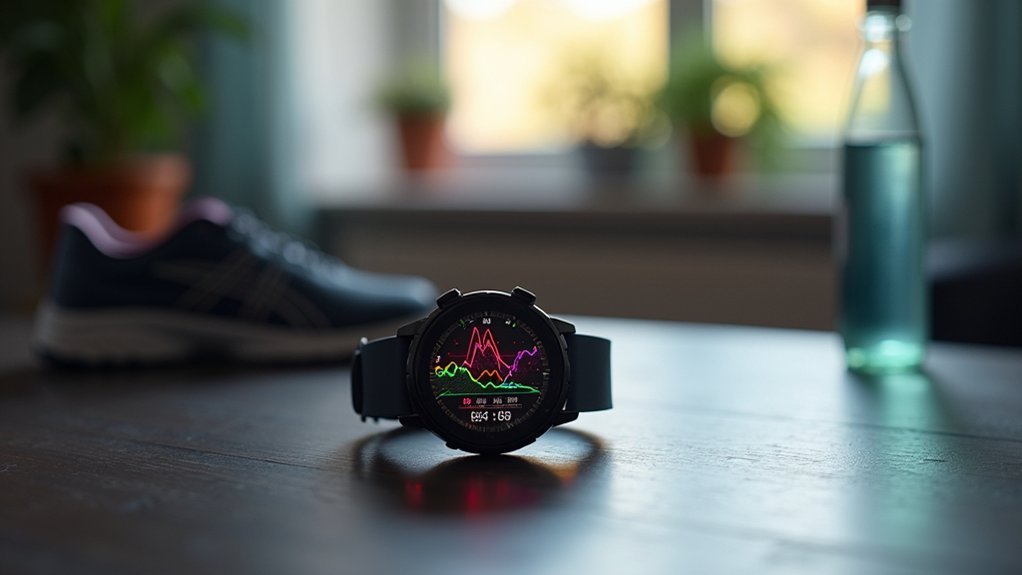
When athletes and fitness enthusiasts seek reliable measures of recovery status, Heart Rate Variability (HRV) stands as the gold standard in performance monitoring. HRV measures the time intervals between consecutive heartbeats, providing a window into your autonomic nervous system function.
Heart Rate Variability reveals your recovery status by measuring beat-to-beat intervals, offering unparalleled insight into autonomic function.
Your sport watch’s HRV metrics—primarily RMSSD and frequency domains—reflect your body’s recovery state. Higher HRV typically indicates better recovery, while lower readings suggest stress or inadequate rest. After intense workouts, you’ll notice your HRV temporarily decrease before returning to baseline as you recover.
What makes HRV particularly valuable is its individualized nature. Your personal baseline matters most, not comparison to others. For optimal results, you should measure HRV in the morning immediately after waking up.
Modern wearables track these patterns accurately, helping you prevent overtraining and optimize your training schedule based on your body’s actual readiness.
Training Load and Status: Understanding Your Exercise Impact
Unlike subjective measures of fatigue, Training Load (TL) provides you with quantifiable data about how your workouts affect your body over time. By combining intensity and duration into a single value, TL helps you track your training stress through heart rate data and EPOC measurements.
Your watch calculates daily TL scores and aggregates them into critical timeframes: 7-day averages reflect recent stress, while 42-day averages indicate your baseline fitness. Comparing these metrics reveals whether you’re maintaining balance or risking overtraining. Experts recommend following the 10% rule when increasing your weekly Training Load to ensure safe progression and avoid injury.
For ideal results, you’ll want to monitor both aerobic effects (improving cardio below lactate threshold) and anaerobic impacts (enhancing high-intensity capacity). This all-encompassing approach lets you maximize fitness gains while minimizing injury risk by ensuring your training progression matches your recovery capacity.
Sleep Quality Metrics: The Foundation of Effective Recovery
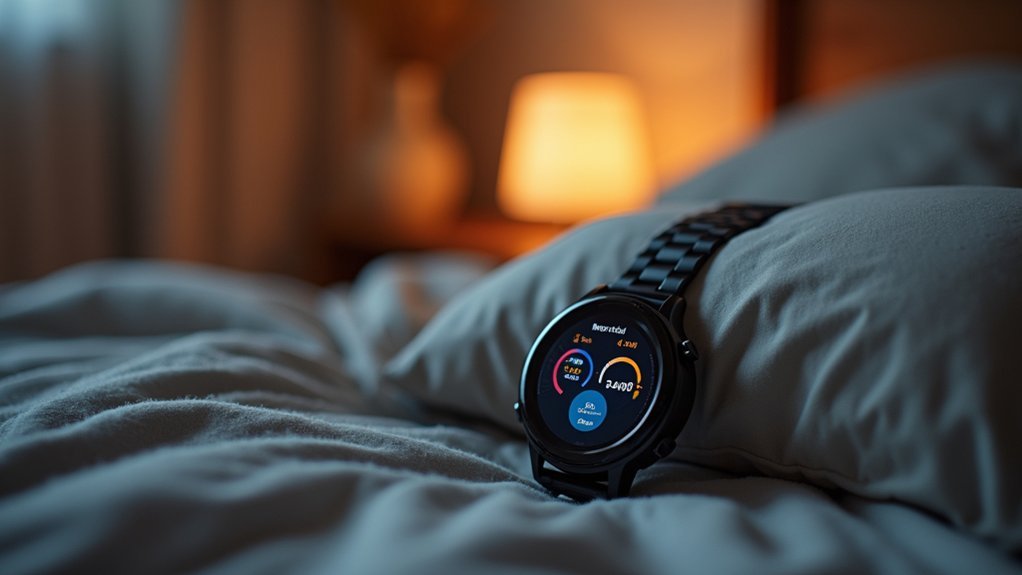
While wearable technology can track your deep and REM sleep stages, which directly impact hormone regulation and muscle recovery, it’s the regularity of your sleep schedule that often outweighs total hours in bed.
Your watch’s recovery score combines these sleep metrics with heart rate variability and respiratory rate to create a thorough picture of your readiness to train.
Understanding these connections helps you make informed decisions about training intensity based on objective sleep quality data rather than subjective feelings of fatigue. Research shows that athletes should aim for approximately 8 hours of sleep to avoid neurobehavioral deficits that can negatively impact performance.
Sleep Stages Matter
As athletes push their bodies to peak performance, understanding sleep stages becomes essential for effective recovery. Your sport watch should track both the quantity and quality of your sleep cycles, particularly deep sleep where most physical repair occurs. The brain cycles through four distinct sleep stages, each with different frequencies that contribute to overall recovery efficiency.
| Sleep Stage | Recovery Benefit |
|---|---|
| Slow-Wave Sleep | Growth hormone release, muscle repair |
| REM Sleep | Cognitive restoration, memory consolidation |
| Light Sleep | Initial recovery, cardiovascular regulation |
| Sleep Cycles | Ideal is 6-7 complete cycles per night |
| Deep Sleep % | Aim for 50% of total sleep time |
When your watch monitors these metrics, you’ll gain insights into your body’s recovery patterns. This data helps you adjust training intensity based on your sleep quality, ensuring you’re not overtraining when your body hasn’t fully recovered from previous sessions.
Consistency Over Duration
Despite common assumptions, consistency in sleep patterns often outweighs sheer duration when it comes to athletic recovery. While you might focus on getting those coveted eight hours, maintaining regular sleep schedules—even on weekends—proves more beneficial for your body’s repair processes.
Your sport watch should track not just total sleep time but the consistency of your sleep patterns. Devices that monitor your average sleep hours and highlight deviations from your normal schedule provide actionable insights for recovery optimization. This data becomes particularly valuable when adjusting for travel and competition schedules.
Elite athletes who prioritize sleep consistency report better hormonal balance, enhanced muscle repair, and improved cognitive function. By emphasizing regular sleep-wake cycles rather than occasional long sleep sessions, you’ll support more effective recovery and ultimately boost performance. This approach is especially important given that 50-78% of elite athletes report sleep disturbances that can significantly impact their performance and recovery.
Recovery Score Integration
Modern sport watches now integrate sophisticated sleep quality metrics into extensive recovery scores, giving you deeper insights than simple duration tracking alone.
These devices monitor sleep efficiency, fragmentation, and WASO data, essential metrics that correlate directly with your body’s ability to repair muscle tissue and regulate hormone production. The ability to track these metrics is particularly valuable as quality sleep aids in muscle glycogen replenishment, which provides critical energy for your next workout.
- Real-time alerts when sleep quality drops below your baseline, empowering you to adjust training intensity before overtraining symptoms appear
- Personalized recommendations based on your unique sleep patterns, eliminating the guesswork from recovery planning
- Combined objective and subjective data that creates a thorough picture of recovery status, revealing patterns you’d never notice through feeling alone
Resting Heart Rate: What Your Morning Pulse Reveals
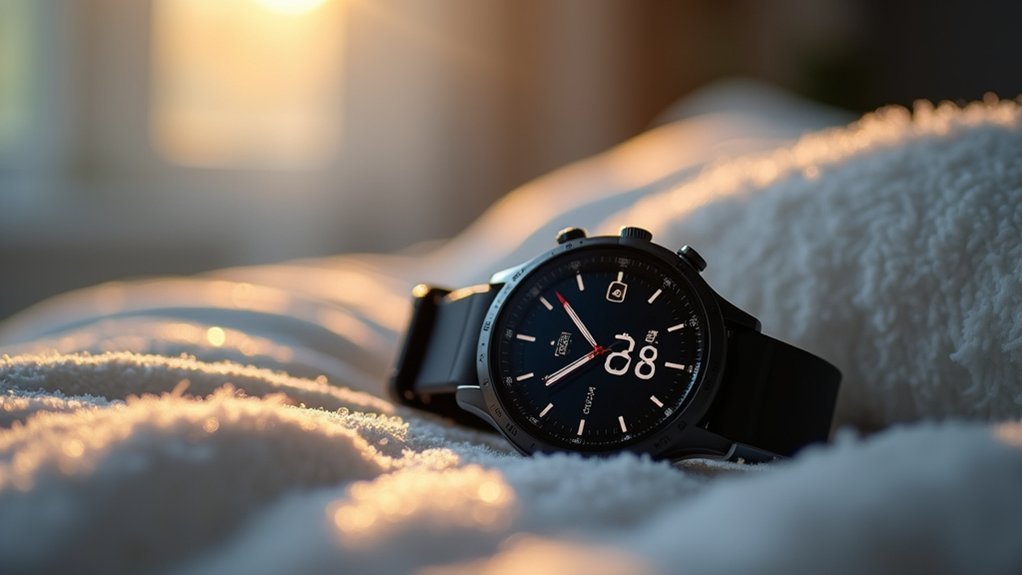
Your morning pulse offers a window into your overall cardiovascular health and recovery status. A normal adult resting heart rate (RHR) ranges between 60-100 beats per minute, with lower rates typically indicating better fitness and heart efficiency.
For the most accurate reading, check your pulse immediately after waking, before any activity. The ideal measurement window is between 3-7am when your heart rate naturally reaches its lowest point. After just 4 minutes of complete rest, your heart rate stabilizes to its true resting value. Regular exercise can significantly impact your RHR, potentially lowering it by 1 beat weekly.
Tracking your RHR trends can reveal valuable insights: sudden increases might signal overtraining, illness, or stress, while a gradually decreasing RHR often reflects improving cardiovascular fitness.
This simple metric provides an inexpensive, non-invasive way to monitor your health daily.
Muscle Load Assessment: Tracking Specific Body Stress Points
Your watch’s muscle load assessment provides a detailed visualization of strain across different muscle groups, highlighting potential problem areas before they become injuries.
You’ll see exactly which zones are under the most stress during your workouts, enabling targeted recovery protocols for those specific regions.
This zone-specific tracking allows you to adjust your training and recovery strategies based on actual biomechanical data rather than subjective feelings of fatigue. The most advanced watches like the Garmin Fēnix 8 Solar offer 112 activity profiles that can precisely measure muscle load across a wide range of sports and activities.
Muscle Strain Visualization
How exactly do advanced sport watches determine which muscles need recovery? They utilize embedded strain sensors that detect deformations in your muscles and tendons during activity.
These sensors track micro-level mechanical stress, creating detailed maps of where strain accumulates throughout your workout. This technology works similarly to how visualization techniques help athletes maintain muscle memory during injury recovery periods.
Your watch then translates this data into actionable insights through:
- Color-coded heatmaps that instantly show which muscles are approaching dangerous fatigue levels – red zones demand immediate attention
- Time-lapse visualizations revealing how strain builds during specific movements, helping identify exactly when your form deteriorates
- Personalized thresholds that vibrate or flash warnings when you’re pushing a vulnerable area too hard, preventing potential injuries before they occur
Modern watches don’t just track effort—they visualize exactly where recovery is needed most.
Zone-Specific Recovery Tracking
While general recovery scores provide a useful overview, modern sport watches now excel at pinpointing exactly which muscles need attention through zone-specific recovery tracking.
Using advanced IMU sensors and machine learning algorithms, your watch can assess muscle load across different body zones during workouts.
You’ll receive real-time feedback on which muscle groups are experiencing excessive strain, helping prevent injuries before they occur.
These systems isolate specific zones—like quadriceps, hamstrings, or upper back—to create personalized recovery recommendations.
Many users find that metrics like heart rate variability and sleep tracking are more valuable indicators of overall readiness and recovery than the zone-specific muscle assessments.
Recovery Time Recommendations: How Long Until Your Next Workout
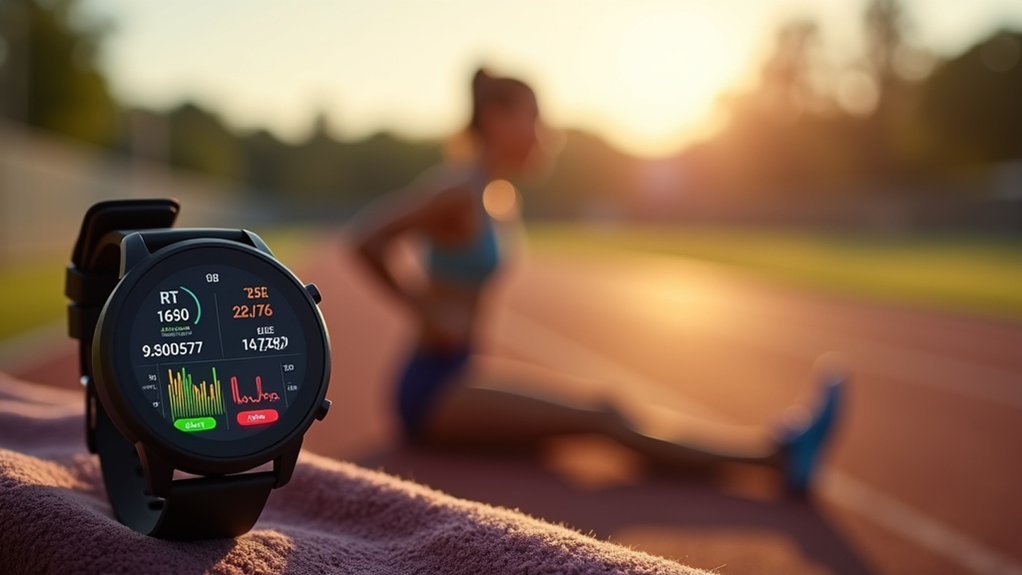
Determining the ideal time between workouts represents a critical aspect of any training regimen.
Modern sport watches can estimate recovery timeframes based on your workout intensity, muscle groups targeted, and personal fitness profile. While the standard recommendation suggests 48-72 hours between training the same muscle group, your watch can provide personalized guidance that accounts for your unique recovery patterns. Those engaging in endurance training may benefit from having their watches monitor when to schedule active recovery days between consecutive training sessions.
- Feel empowered by receiving tailored recovery recommendations that maximize your gains while preventing overtraining and injury
- Experience confidence in knowing exactly when your body is truly ready for your next high-intensity session
- Enjoy peace of mind as your watch adapts its recommendations based on your sleep quality, stress levels, and previous workout intensity
Personalized Recovery Based on Fitness Level
Unlike generic recovery recommendations, personalized recovery metrics based on your individual fitness level provide far more accurate guidance for your training regimen. Your fitness level greatly impacts how quickly you bounce back from workouts, making it essential for your watch to factor this into recovery calculations.
Advanced watches like COROS and Garmin Fenix 7 now integrate fitness benchmarks to prevent recovery over- or under-estimation. They analyze your training load, performance feedback, and workout intensity relative to your current capabilities. The Garmin Enduro 3 takes this further with its improved user interface for easier tracking of recovery metrics.
Modern fitness wearables calibrate recovery metrics to your personal fitness profile, ensuring truly individualized training guidance.
When you’re fitter, you’ll recover faster from the same workout than someone less conditioned.
This personalization becomes increasingly valuable long-term, as your recovery metrics evolve alongside your changing fitness status, enabling smarter progressive overload while minimizing injury risk.
Advanced Physiological Markers: Beyond Basic Heart Rate Monitoring
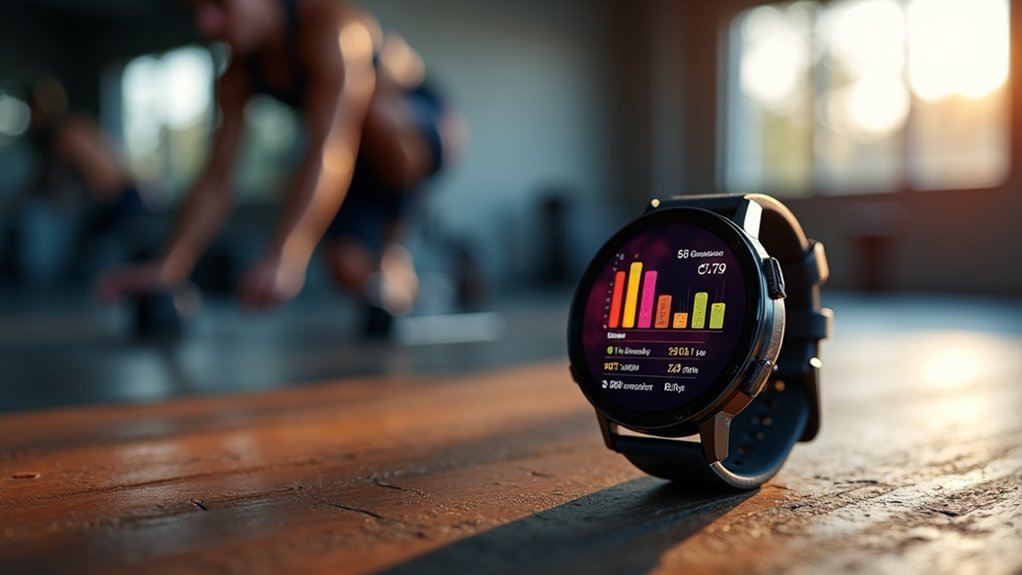
Modern sport watches have evolved far beyond basic heart rate monitoring, now incorporating sophisticated physiological markers that provide deeper insights into your body’s recovery state. These advanced metrics analyze how your physiological systems respond to training stress and adapt during recovery periods.
- Sweat analysis biosensors track glucose, lactate, electrolytes, and cortisol levels in real-time, giving you unprecedented visibility into your metabolic state and stress response without invasive blood draws.
- HRV measurements assess your autonomic nervous system recovery, helping you avoid overtraining by revealing when your body needs more rest – even when you feel mentally ready. Athletes often misinterpret persistent fatigue as a need to train harder when it actually signals the body requires proper recovery time.
- Neurophysiological markers like cognitive performance tests help identify central nervous system fatigue that traditional metrics might miss, ensuring your brain recovers alongside your muscles.
Frequently Asked Questions
Can Recovery Metrics Accurately Predict Injury Risk?
Recovery metrics can predict injury risk when combining workload ratios, sensor data, and ML models. You’ll get indicators of potential injuries but they aren’t foolproof due to unmeasured factors like stress and sleep quality.
How Do Hormonal Cycles Affect Recovery Metric Accuracy?
Hormonal cycles considerably impact recovery metric accuracy. You’ll notice fluctuations in heart rate variability and respiratory rates during different phases. Your metrics may appear skewed during the luteal phase when recovery naturally decreases.
Do Recovery Metrics Work for Non-Cardio Activities Like Weightlifting?
Recovery metrics aren’t fully optimized for weightlifting. Your watch’s algorithms prioritize cardiovascular strain, not muscle microtrauma. You’ll get better results by combining watch data with your own assessment of muscle soreness and readiness.
Can Recovery Data Be Affected by Medication or Supplements?
Yes, your recovery data can be greatly affected by medications and supplements. Beta blockers alter HRV readings, stimulants like caffeine increase heart rate, and CNS depressants may improve sleep metrics but complicate overall recovery scores.
How Often Should Recovery Metrics Be Recalibrated for Accuracy?
You should recalibrate recovery metrics whenever significant changes occur in your training, health, or lifestyle. Most devices update dynamically, but manual recalibration helps maintain accuracy after illness, significant weight changes, or new medication regimens.
In Summary
You’ll get the most value from a sport watch that tracks a combination of metrics—HRV, sleep quality, resting heart rate, and training load. Don’t just collect data; use it to guide your decisions. The best recovery insights come when you’re consistent with monitoring and responsive to what your body’s telling you. Remember, recovery isn’t passive—it’s an active component of your performance journey.

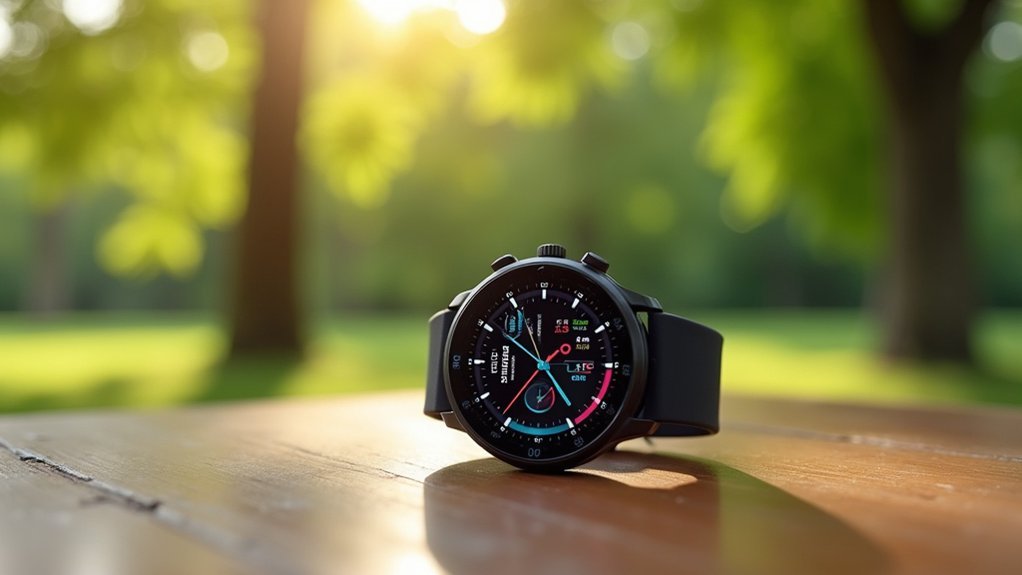



Leave a Reply